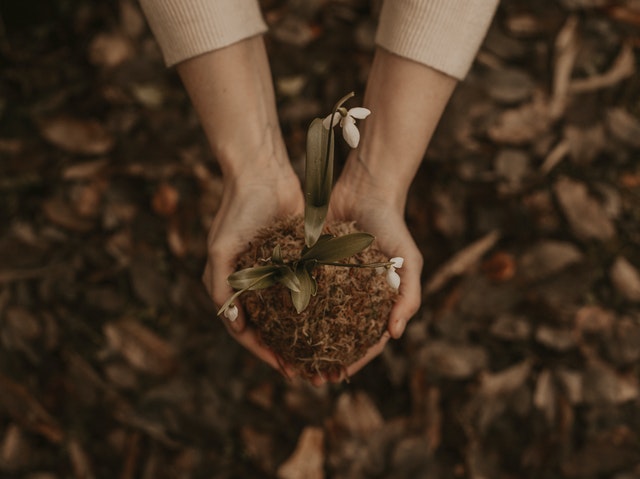Watering and Mulching
This article is a spinet form the book called “SHRUBS AND SMALL TREES” by “SIMON AKEROYD“. Thanks to the author for the useful content and detailed information about mulching. Continue reading about Watering and Mulching techniques for your garden.
For the first few years after planting trees and shrubs, water them regularly. Once established, they should take care of themselves-if you selected and planted them well in the first place.
What to water? direct water onto the soil over the roots, not onto the leaves.A saucer-shaped dip around the main stem creates a reservoir while water soaks down to the roots. Failure to water sufficiently after planting, especially during dry periods, will compromise growth and may kill the plant. If it is still struggling and wilting after three years, then something serious is wrong; consider replacing it with a plant more suitable to the conditions. Plants in containers will need frequent watering, probably every soil will conserve moisture by reducing evaporation.
Wise ways to water
Choose plants that can cope with drought, if this is likely to be a problem, and don’t water mature trees and shrubs. Lay soaker hoses to provide a steady flow of water to where it is needed, and water in the evening or early morning when less will evaporate. No matter how small your garden, there should be room for at least one rain barrel. These containers catch and store rainwater, which is ideal for watering plants; they may also save you money if your water supply is metered. Add organic matter to the soil, as it helps to retain moisture.
Why use mulch? First, mulch helps to seal in soil moisture, thereby reducing evaporation and water loss. Mulches made from organic matter act like a sponge, absorbing the moisture from rain and the air and then slowly releasing it to the plan t roots below. Second, as an organic mulch slowly rots, it is taken down toward the roots by worms and the rain, improving the soil structure. Third, mulch will suppress weeds by excluding light from the soil surface and hindering their development. This only tends to work if the mulch is sterile, which is usually true for store-bought mulch, but homemade garden compost may contain weed seeds. As the surface of newly laid mulch is quite loose, however, it is quite easy to destroy emergent weeds by shallow hoeing. Also remember to keep organic mulch away from shrub and tree stems, as the moisture they retain can rot the wood.
Mulching Materials
Wood-chip or bark mulch is the favourite choice for tree and shrub borders, as it blends in with the surroundings. Weeds cannot easily germinate in it, and as it is slow to rot down it needs to be replenished less frequently than compost or manure. Gravel is a popular mulch for rock gardens, Japanese designs, and Mediterranean and herb gardens. It is a good idea to lay landscape fabric, such as woven polypropylene, under gravel. This is permeable to water yet impermeable to weeds, but fabric is unsightly, so it needs to be covered with loose mulch.
Weeding And Fertilizing
For a beautiful garden, you must remember to weed and feed. Weeds compete with your plants for nutrients and moisture in the soil, while fertilizers promote healthy and strong growth.
Why weeds? Not only can weeds look unsightly, but they also compete with trees and shrubs for three vital resources: water, light, and nutrients. It is worth bearing in mind, however, that a weed is just a plant growing in the wrong place. If you can tolerate a few weeds in out-of -the-way places, the wildlife will thank you for it.
Weeding methods the most effective method of weed control is to cover the soil with plants. Ground-cover shrubs are ideal for this purpose and leafy tree canopies reduce the amount of light and moisture available to the weeds. Other areas of bare soil should be covered with mulch (seep.112). Hand-weeding is the simplest method of control, and the most effective weeding tool is the border fork. Hoeing is useful for removing weeds on bare patches of ground, but it can damages surface roots if you hoe too close to trees and shrubs. Annual weeds can be simply pulled out before they have a chance to set seed, but perennial weeds need tougher action. Either treat them with a weedkiller or dig out the roots meticulously. Chop up perennial weeds into tiny pieces, multiplying them by hundreds of times.
Using Weedkillers herbicides can be very effective, particularly if you have a large area of perennial weeds to tackle. They can be bought either ready-mixed as a spray or as a concentrated liquid that requires dilution and application with a watering can or backpack sprayer. Always wear appropriate protective clothing as recommended on the label and follow the manufacturer’s instructions and rate of application. You must be careful not to get herbicide on yourself or any ornamental plants growing nearby; for this reason it is always good practice to apply herbicides on still, windless day. Systemic weedkillers, usually containing the active ingredient glyphosate, are effective on perennial weeds as they absorb the chemical and take it down into the roots. Contact weedkillers burn off leaves and stems but won’t kill the roots. They are suitable for annual weeds only.
Choosing plant foods Fertilizers are plant foods containing essential nutrients. Most are supplied in a concentrated form and contain the tree major nutrients essential for plant growth, in varying ratios: Nitrogen (N), phosphorus (p), and potassium or potash (k), look for the n:p:k ratio on the packet. Nitrogen encourages vegetative growth, phosphorus promotes healthy roots, and potash helps flowering and fruiting. General-purpose fertilizers contain these nutrients in almost equal amounts and can be applied to the soil prior to planting or as a general fertilizer to keep plants healthy. Rose fertilizers are high in potash; they are also suitable for established trees and shrubs that are grown for their flowers or fruit. Organic fertilizers include dried bone, bonemeal, hoof and horn, and seaweed. Controlled-release fertilizers are generally only used at planting time or for containers plants.
When and how to apply fertilizer Most established trees and shrubs require no fertilizer. When they do, use a foliar spray applied onto the leaves, as it is the most effective method. Plants in containers benefit from a general fertilizer every week during the growing season. Give sickly-looking specimens a general fertilizer in spring. Avoid fertilizing plants after midsummer as this stimulates growth that will not have time to ripen prior to winter, which may then be damaged by frost. Fertilizers usually come in granular form or as a concentrated liquid, which requires mixing with water. wear gloves when handling all forms of fertilizer, and always follow the manufacturer’s instructions, applying them at the recommended rates. Don’t fertilize plants if heavy rain is forecast, as nutrients may be washed away, or under the midday sun on hot days; plants fed at this time can suffer from sun scorch.
Quick fixes for sickly plants trees and shrubs may need a quick pick-me-up if they start to look unhealthy6. Pale green leaves and weak, poor growth are often due to a lack of nitrogen. This requires a high-nitrogen fertilizer to remedy the problem, such as sulfate of ammonia. Dried blood can also be used. Brown discoloration or blotches on the leaves, leaf margins, or leaf tips is usually a sigh of a potassium deficiency. Apply a high-potash solution, such as tomato fertilizer or sulfate of potash. Stunted growth and pale leaves could be phosphate deficiency; apply bone meal or superphosphate. Yellowing between the veins is commonly seen on acid-loving plants, such as rhododendrons and camellias. It is caused by manganese or iron deficiency, where alkaline soil prevents these nutrients from being absorbed. Construction rubble and mortar can be a culprit. Treat with sequestered iron.
We hope this article about watering and mulching was useful. Continue reading about “Mastering Fruiting“

